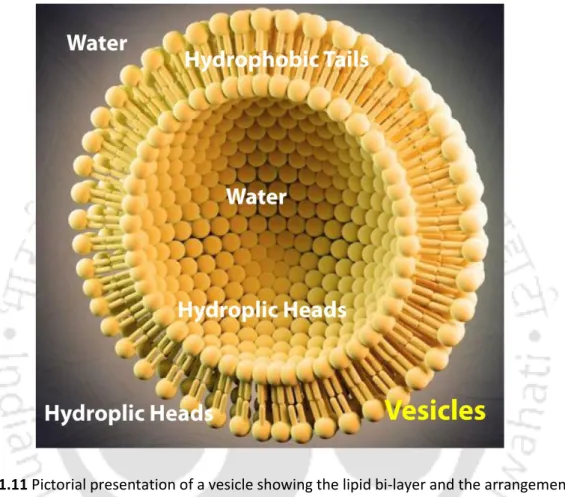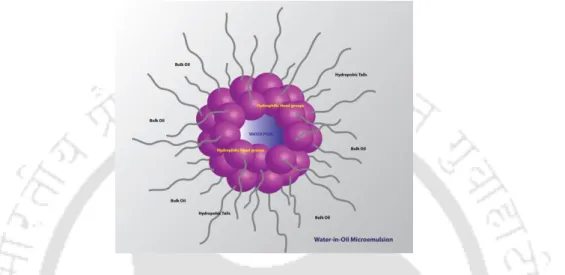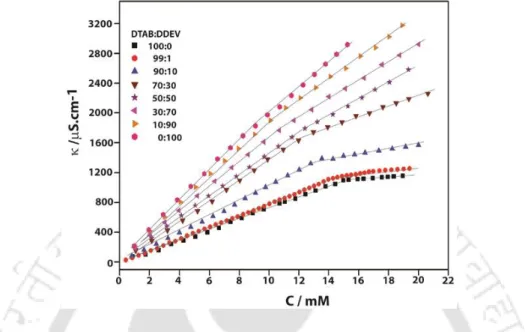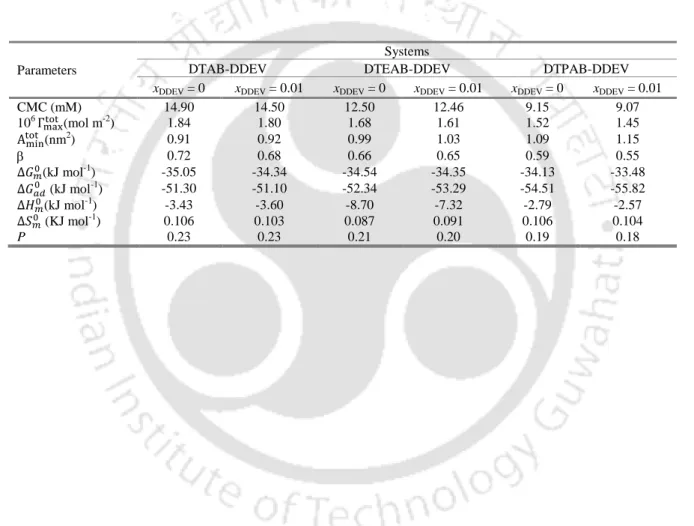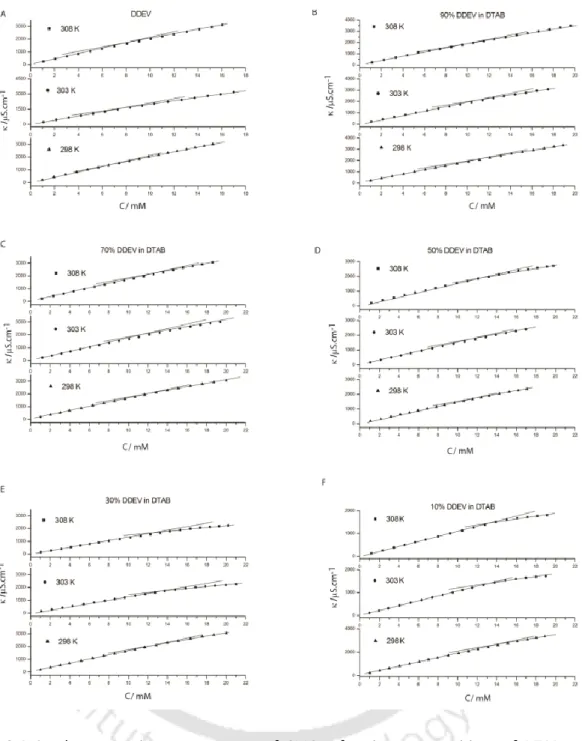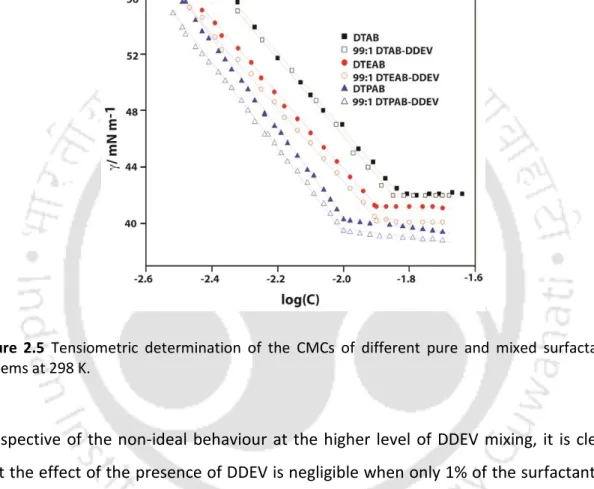Abstract
Chapter 4 describes the mechanism of micelle to vesicle transformation by viologen amphiphiles in presence of Cucurbit[8]uril and DHN. In this chapter we have also shown two
Acknowledgements
LIST OF ABBREVIATIONS
Prelude
Although the existence of intermolecular forces was first proposed by Johannes Diderik van der Waals in 1873,1 it was Emil Fischer who developed the philosophical roots of supramolecular chemistry in 1894 by postulating the famous "lock and key" model for enzyme-substrate interactions . 2 The essential principles of molecular recognition and host-guest chemistry were thus introduced. Pedersen provided the breakthrough in the 1960s with the synthesis of crown ethers (Figure 1.1).4 Crown ethers were the first of their kind, synthetic macrocyclic hosts capable of incorporating guests through noncovalent bonding.
Cucurbiturils
The binding of CB[n] to different guest molecules occurs mainly through two different supramolecular interactions, an ion-dipole interaction at the portal region and a hydrophobic interaction within the cavity. This unique property of CB[8] has been widely exploited as a "molecular fox" for the preparation of various types of soft materials.
![Figure 1.2 Top and side views of the X-ray crystal structures of CB[5], CB[6], CB[7], CB[8], and CB[5]@CB[10].The various compounds are drawn to scale (taken from ref](https://thumb-ap.123doks.com/thumbv2/azpdfnet/10341807.0/23.892.137.758.127.384/figure-views-crystal-structures-various-compounds-drawn-scale.webp)
Surfactants and their Self-assembly
When single-chain amphiphiles are added to water, they form both monolayers on the water surface and micelles, while double-chain amphiphiles form bilayers instead of micelles (Fig. Such a bilayer, when it takes the form of closed spheres, is popularly known as vesicles or liposomes. Structurally, water forms a microdroplet, surrounded by a monolayer of surfactant molecules organized by their polar heads.
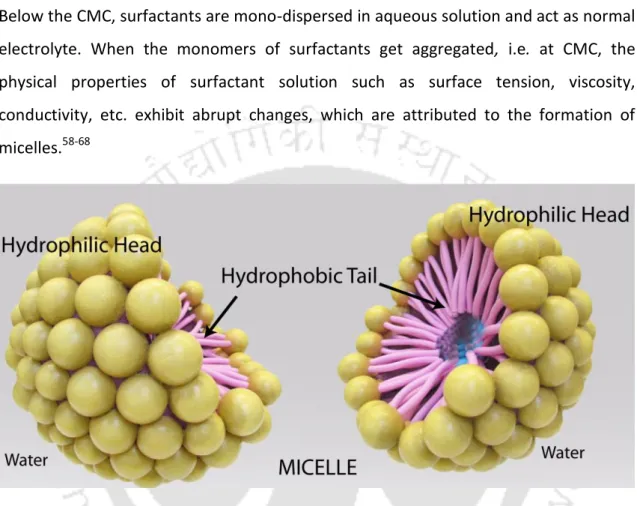
Viologen and Viologen Amphiphiles
Cyclic voltammograms of LB films revealed one or two pairs of one electron transfer process, corresponding to viologen-MWCNT hybrids with cathodic and anodic potentials closely related to the alkyl chains of viologens.93 Although the ability of viologens and their amphiphiles to act because the acceptor known for a long time in these charge transfer processes, there has recently been interest in the design of such self-assemblies and their use as new soft materials for various applications. One likely reason for the lack of such information is the poor amphiphilic properties of these surfactants.

Host-Guest Interaction of CB[n] with Surfactants
The micellization behavior and properties of viologen surfactants are important parameters to be analyzed in order to efficiently use these classes of amphiphiles for the construction of new compounds. The planar doubly charged headgroup presumably leads to an inappropriate hydrophile-lipophile equilibrium (HLB) for these surfactants to organize themselves efficiently.
![Figure 1.14 Different modes of binding of CB[5], CB[7], and CB[8] with various surfactants and their micelles](https://thumb-ap.123doks.com/thumbv2/azpdfnet/10341807.0/37.892.125.769.135.620/figure-different-modes-binding-cb-various-surfactants-micelles.webp)
Objectives of the Present Thesis
The observation of vesicle formation by viologen surfactants through triple complexation with CB[8] and DHN is quite surprising considering the poor self-assembly ability of viologen surfactants. Development of stimuli-sensitive vesicles using ternary complex-mediated vesicle formation from viologenic surfactants.
Present Thesis
The phase boundaries were observed to be very similar to those of the pure tetraalkylammonium surfactants. The resulting vesicles were observed to be sensitive to UV light (365 nm), as the trans-cis isomerization of the Azo group leads to the disruption of the ternary complex.
Introduction
The search for a suitable binary combination will also allow us to prepare other types of membrane mimetic systems, such as water-in-oil (w/o) microemulsions and vesicles with special characteristics that otherwise cannot be obtained without one of the components. . The aim of this study is to design a micellar system incorporating viologen at the air/water interface while keeping the micellar and thermodynamic properties of tetraalkylammonium surfactants unchanged.
Results and Discussion
The concentration at which a sudden change in specific conductivity occurred is considered the CMC of the system. The observed CMCs for the binary mixtures fall between the two extremes of pure surfactants. Interestingly, the non-spherical nature of the DDEV micelles is transformed into spherical when mixed with DTAB.
Furthermore, the overall calculated shapes of the micelles remain spherical as was the case for pure tetraalkylammonium surfactants. From the comparative data listed in Table 2.4 it is clear that 1% doping of DDEV does not bring about any significant change in the micellar properties of the pure tetraalkylammonium surfactants, regardless of the head group.
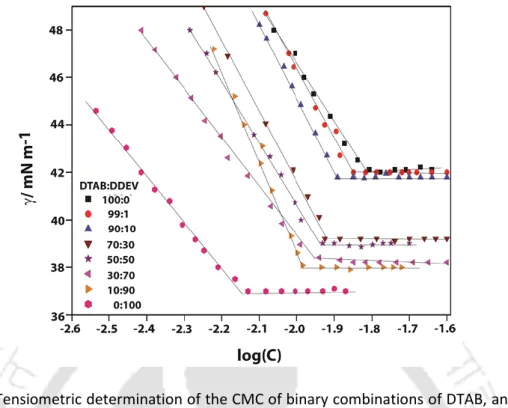
Conclusion
Experimental Section
The surface tension of surfactants at the air/water interface was measured with a tensiometer (Jencon, India) using the du Noȕy ring detachment method. Pre-prepared concentrated aqueous solutions of surfactants were gradually added with Hamilton syringes to a measured amount of water, mixed gently for 2 minutes and kept undisturbed in a constant temperature bath for 10 minutes to reach equilibrium. The surface tensions of these solutions were then measured in triplicate while maintaining the temperature.
The conductivity of the surfactant solutions was taken using a Cyberscan Con-510 (Eutech) conductivity meter with cell constant of 1 cm-1. After adding concentrated stock solutions of surfactants to a measured amount of water, the solutions were stirred for 2 minutes and kept undisturbed for 10 minutes in a constant temperature bath before each measurement.
Introduction
Results and Discussion
The diameters of the vesicles were further confirmed by Dynamic Light Scattering (DLS) experiments (Figure 3.7A). The very slow release of the dye demonstrates the stability of the vesicles at this temperature. The role of the charge transfer complexation was further demonstrated by the addition of cerium (IV) ammonium nitrate (CAN) to the vesicles.
In both cases, the charge transfer bands appeared (data not shown) indicating the formation of the ternary complexes. The diameter of the vesicles increased (30 nm, 106 nm and 120 nm for DTAB, DTEAB and DTPAB respectively) as the headgroup size of the surfactant increased.
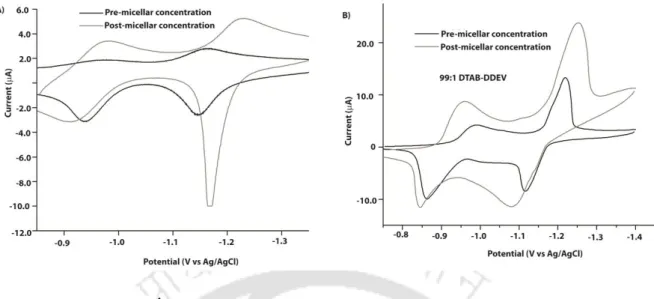
Conclusions
Experimental Section
The resulting suspensions after sonication for 1 h at 333 K were kept undisturbed at 298 K for four days to give clear (DTAB, DTEAB) or slightly cloudy (DTPAB) light purple solutions. The resulting vesicle solutions were passed through Sephadex G-25 to remove excess dye, diluted, and used for fluorescence measurements. Dye release was monitored on a Cary-Eclipse luminescence spectrometer (Agilent) by exciting the solutions at 492 nm and measuring the fluorescence intensity at 512 nm.
A drop of the vesicle solution was placed on a copper grid and held in air for 2-3 minutes, after which the excess solution was blotted with tissue paper. The sample was counterstained with a drop of 2% uranyl acetate solution before removing excess liquid with filter paper.
Introduction
Results and Discussions
ESI-MS (Figure 4.6) of the vesicle also confirmed the formation of the ternary complex between HDEV-DHN and CB[8] as a signal appeared at 949.45 (M2+). Dye quenching in the case of solution A and C suggests vesicle formation and the process is independent of the order of addition of DHN. To understand the situation, we have measured the CMC of the ternary mixture of CTAB-HDEV-CB using surface tension and conduction methods (Figure 4.11).
Investigation of the processes involved in the transformation of the micelles into vesicles revealed some interesting features. Interestingly, the 1 H NMR showed de-complexation of the CTAB@CB[8] binary complex as the only feature.
![Figure 4.3 FESEM images of 0.75 mM (CTAB-HDEV-DHN-CB[8]) showing larger vesicles.](https://thumb-ap.123doks.com/thumbv2/azpdfnet/10341807.0/88.892.137.750.271.1008/figure-fesem-images-ctab-hdev-showing-larger-vesicles.webp)
Conclusions
This process involves two types of self-sorting at CB[8], (i) in HDEV@CB[8], the host moves to the polar headgroup leaving the tail free from its cavity, (ii) the CTAB@CB[ 8] complex degrades, and the host complexes with the violaceous head groups of the remaining HDEV molecules; (f) the charge transfer complex-mediated ternary complex leads to the transformation of the micelles into vesicles.
Experimental Section
Concentrated aqueous solutions of surfactants prepared previously were added progressively with a Hamilton syringe to a measured amount of water, gently stirred for 2 min, and kept in a constant temperature bath at 298 K for 10 min without disturbance to achieve balance. For measuring the CMC of the CTAB-HDEV-CB mixture, a solution of 1 mM strength (for each component) was prepared by mixing the appropriate amount of each component in water, followed by sonication for 6 h. The conductivity of the surfactant solutions was measured using a Cyberscan Con-510 conductivity meter (Eutech) with a cell constant of 1 cm-1.
Samples were prepared by dropping a drop of the vesicle solution onto a glass slide and dried under ambient conditions. The particle sizes of the samples were measured at 298 K on a Zetasizer Nano ZS90 from Malvern using a 632.8 nm He−Ne laser.
Introduction
Scherman and co-workers demonstrated the formation of supramolecular peptide amphiphiles (SPA) and their stimuli-responsive vesicles and used the system as a delivery vehicle.102 Although never tested, aromatic amino acids may be an important substitute for the fused aromatic ring that contains second guests such as DHN, pyrene etc. Based on Urbach's report, herein we systematically studied the ability to form the vesicles by HDEV in combination with CB[8] and aromatic amino acids.45 Interestingly, we observed that although both Phe and Tyr can form ternary complex with MV@ CB[8], they are unable to form vesicles when an asymmetric violet wetting (HDEV) replaces MV. Both Trp and Azo-AA (Scheme 5.1) showed the ability to transform solution of HDEV@CB[8] to vesicles.
The results were further extended to form a supramolecular peptide amphiphile (SPA) by incorporating an azo-amino acid-containing peptide (1, Scheme 5.1) as the head group and its corresponding vesicle, which showed excellent photo-response in addition to other stimuli-responsiveness.
Results and Discussion
All these evidences confirmed the formation of the ternary complex between Azo-AA-HDEV-CB [8]. The size of the vesicles was further confirmed by DLS measurements which showed similar particle size (Figure 5.14). The faster release is attributed to the faster discharge of the dye molecules from the vesicle.
Interestingly, no increase in fluorescence intensity was observed for dye release after DHN addition (Figure 5.21). The DLS distribution of the DHN-treated solution showed a slight decrease in particle size (Figure 5.23).
![Figure 5.1 shows a representative overlay of the three spectra for Trp in absence and presence of HDEV and CB[8]](https://thumb-ap.123doks.com/thumbv2/azpdfnet/10341807.0/110.892.142.758.414.1084/figure-shows-representative-overlay-spectra-absence-presence-hdev.webp)
Conclusions
Experimental Section
FESEM samples were prepared by pouring a drop of the vesicle solution (0.075 mM) onto a glass slide and drying under ambient conditions. Complexation of ferrocene derivatives by the Cucurbit[7]uril host: a comparative study of the Cucurbituril and Cyclodextrin host families. Kim, Control of the stoichiometry in host-guest complexation by guest redox chemistry: incorporation of methyl viologen in Cucurbit [8] uril.
Selective Inclusion of a Hetero-Guest Pair in a Molecular Host: Formation of Stable Charge-Transfer Complexes in Cucurbit[8]uril. Correlating solution binding and ESI-MS stability by including solvation effects in a confined cucurbit[8]uril system.
![Figure 1.1 Various supramolecular hosts and their 3D arrangements: a)-cyclodextrin; b) 18- 18-Crown-6-ether with potassium ion; c) calixarene; d) cucurbit[7]uril.](https://thumb-ap.123doks.com/thumbv2/azpdfnet/10341807.0/21.892.132.763.331.859/figure-various-supramolecular-arrangements-cyclodextrin-potassium-calixarene-cucurbit.webp)
![Figure 1.4 Various types of charged organic species as guests for CB[6] and CB[7].](https://thumb-ap.123doks.com/thumbv2/azpdfnet/10341807.0/25.892.135.746.310.997/figure-various-types-charged-organic-species-guests-cb.webp)
